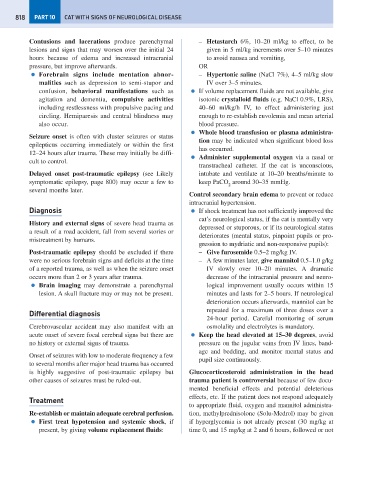Page 826 - Problem-Based Feline Medicine
P. 826
818 PART 10 CAT WITH SIGNS OF NEUROLOGICAL DISEASE
Contusions and lacerations produce parenchymal – Hetastarch 6%, 10–20 ml/kg to effect, to be
lesions and signs that may worsen over the initial 24 given in 5 ml/kg increments over 5–10 minutes
hours because of edema and increased intracranial to avoid nausea and vomiting,
pressure, but improve afterwards. OR
● Forebrain signs include mentation abnor- – Hypertonic saline (NaCl 7%), 4–5 ml/kg slow
malities such as depression to semi-stupor and IV over 3–5 minutes.
confusion, behavioral manifestations such as ● If volume replacement fluids are not available, give
agitation and dementia, compulsive activities isotonic crystalloid fluids (e.g. NaCl 0.9%, LRS),
including restlessness with propulsive pacing and 40–60 ml/kg/h IV, to effect administering just
circling. Hemiparesis and central blindness may enough to re-establish euvolemia and mean arterial
also occur. blood pressure.
● Whole blood transfusion or plasma administra-
Seizure onset is often with cluster seizures or status
tion may be indicated when significant blood loss
epilepticus occurring immediately or within the first
has occurred.
12–24 hours after trauma. These may initially be diffi-
● Administer supplemental oxygen via a nasal or
cult to control.
transtracheal catheter. If the cat is unconscious,
Delayed onset post-traumatic epilepsy (see Likely intubate and ventilate at 10–20 breaths/minute to
symptomatic epilepsy, page 800) may occur a few to keep PaCO around 30–35 mmHg.
2
several months later.
Control secondary brain edema to prevent or reduce
intracranial hypertension.
Diagnosis ● If shock treatment has not sufficiently improved the
cat’s neurological status, if the cat is mentally very
History and external signs of severe head trauma as
depressed or stuporous, or if its neurological status
a result of a road accident, fall from several stories or
deteriorates (mental status, pinpoint pupils or pro-
mistreatment by humans.
gression to mydriatic and non-responsive pupils):
Post-traumatic epilepsy should be excluded if there – Give furosemide 0.5–2 mg/kg IV.
were no serious forebrain signs and deficits at the time – A few minutes later, give mannitol 0.5–1.0 g/kg
of a reported trauma, as well as when the seizure onset IV slowly over 10–20 minutes. A dramatic
occurs more than 2 or 3 years after trauma. decrease of the intracranial pressure and neuro-
● Brain imaging may demonstrate a parenchymal logical improvement usually occurs within 15
lesion. A skull fracture may or may not be present. minutes and lasts for 2–5 hours. If neurological
deterioration occurs afterwards, mannitol can be
repeated for a maximum of three doses over a
Differential diagnosis
24-hour period. Careful monitoring of serum
Cerebrovascular accident may also manifest with an osmolality and electrolytes is mandatory.
acute onset of severe focal cerebral signs but there are ● Keep the head elevated at 15–30 degrees, avoid
no history or external signs of trauma. pressure on the jugular veins from IV lines, band-
age and bedding, and monitor mental status and
Onset of seizures with low to moderate frequency a few
pupil size continuously.
to several months after major head trauma has occurred
is highly suggestive of post-traumatic epilepsy but Glucocorticosteroid administration in the head
other causes of seizures must be ruled-out. trauma patient is controversial because of few docu-
mented beneficial effects and potential deleterious
effects, etc. If the patient does not respond adequately
Treatment
to appropriate fluid, oxygen and mannitol administra-
Re-establish or maintain adequate cerebral perfusion. tion, methylprednisolone (Solu-Medrol) may be given
● First treat hypotension and systemic shock, if if hyperglycemia is not already present (30 mg/kg at
present, by giving volume replacement fluids: time 0, and 15 mg/kg at 2 and 6 hours, followed or not

